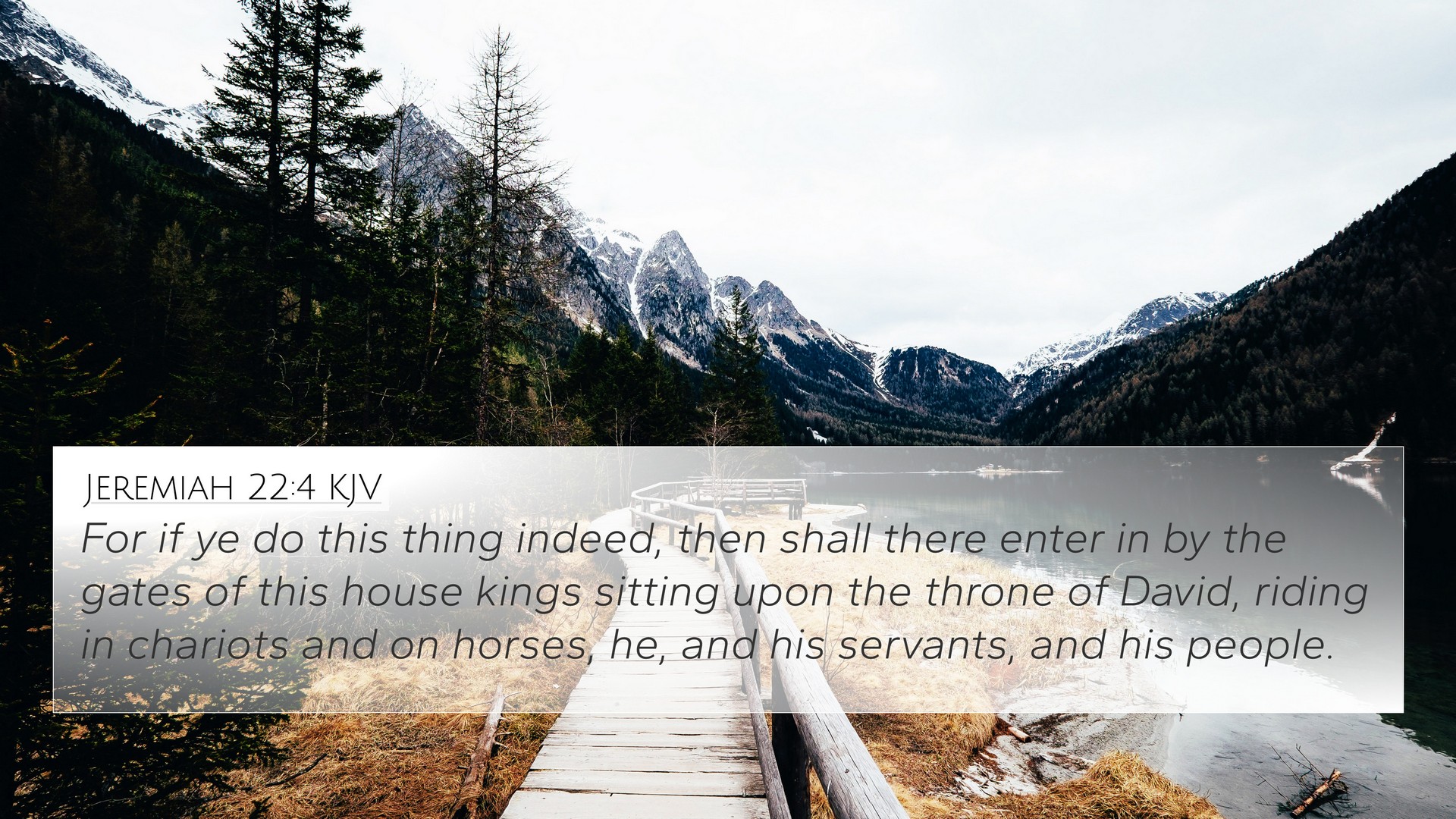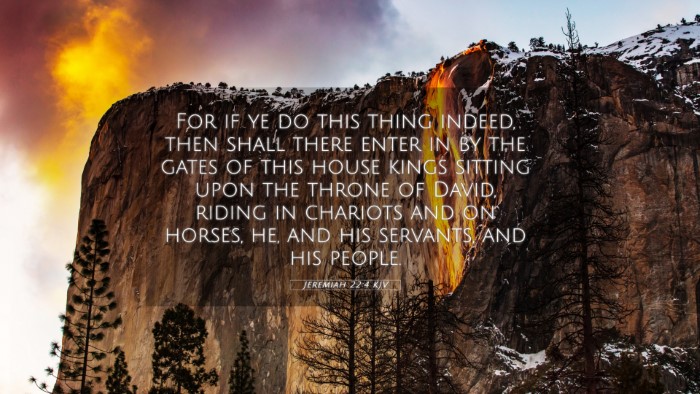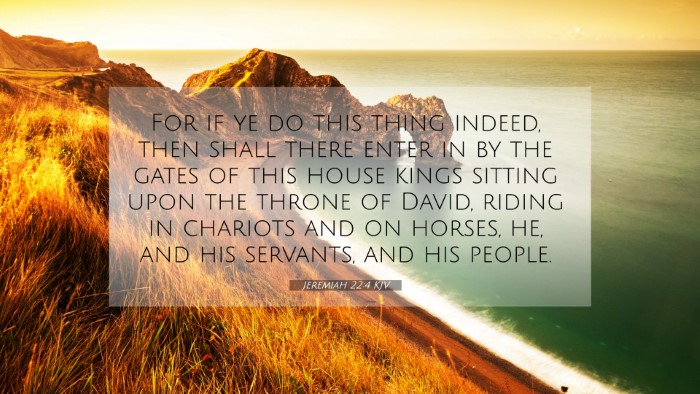Understanding Jeremiah 22:4
Verse: Jeremiah 22:4 (KJV) - "For if you do this thing indeed, then shall there enter in by the gates of this house kings sitting upon the throne of David, riding in chariots and on horses, they, and their servants, and their people."
Summary of Meaning
This verse from the Book of Jeremiah appeals to the leadership of Judah, promising that obedience to God's commandments would lead to the prosperity and authority of Davidic kings entering the royal palace. It emphasizes the importance of adherence to divine principles as a pathway to blessings and historical continuity in God's plan.
Commentary Insights
Scholars like Matthew Henry, Albert Barnes, and Adam Clarke provide insights that encapsulate the richness of this text:
- Matthew Henry's Commentary: This verse is a conditional promise focusing on the leadership's duty to govern righteously. Henry emphasizes that God's favor is linked to the moral conduct of leaders. If they indeed obey and practice justice, they will witness a legacy of Davidic kings, suggesting that leadership is intertwined with divine accountability.
- Albert Barnes' Notes: Barnes elucidates on the significance of riding in chariots and horses, which symbolizes power and glory. He relates this to God's covenant with David, indicating that the kingship is established through God's unwavering faithfulness to His promises. This reflects not just a physical presence in the gates but a deeper spiritual inheritance that comes with adherence to God's will.
- Adam Clarke's Commentary: Clarke reflects on the physical gates as well, indicating that they served as the entry point for rulers and signified a place of judgment and authority. The imagery of kings suggests a future hope where God's providence ensures that righteous leaders will prevail, enhancing the theme of restoration and continuity of David’s line.
Bible Verse Cross-References
Jeremiah 22:4 is intricately connected to several other biblical texts. Thematic connections can be seen as follows:
- 2 Samuel 7:16: "And thine house and thy kingdom shall be established for ever before thee: thy throne shall be established for ever." - Reinforcing God’s promise to David.
- 1 Kings 2:4: "That the Lord may continue his word which he spake concerning me, saying, If thy children take heed to their way, to walk before me in truth with all their heart and with all their soul, there shall not fail thee a man on the throne of Israel." - A direct affirmation of obedience leading to divine blessing for David’s lineage.
- Isaiah 9:7: "Of the increase of his government and peace there shall be no end, upon the throne of David, and upon his kingdom..." - A prophetic connection to the sovereignty established in David's line.
- Jeremiah 33:17: "For thus saith the Lord; David shall never want a man to sit upon the throne of the house of Israel." - A reiteration of the eternal promise to David.
- Matthew 1:1: "The book of the generation of Jesus Christ, the son of David, the son of Abraham." - Connecting Jesus with the Davidic lineage.
- Revelation 22:16: "I, Jesus, have sent mine angel to testify unto you these things in the churches. I am the root and the offspring of David, and the bright and morning star." - A New Testament affirmation of the fulfillment of God’s promise.
- Luke 1:32-33: "He shall be great, and shall be called the Son of the Highest: and the Lord God shall give unto him the throne of his father David." - Continuation of the promise through Christ.
Tools for Bible Cross-Referencing
Understanding connections between Bible verses is integral for meaningful Bible study. Below are some tools:
- Bible Concordance: A valuable tool for locating verses and their themes.
- Bible Cross-Reference Guide: Helps identify parallels and cross-references across scriptures.
- Cross-Reference Bible Study Platforms: Online tools offer ways to see interconnectedness within the scriptures.
- Comprehensive Cross-Reference Materials: Books and resources provide a thorough analysis of scripture connections.
How to Use Bible Cross-References
To deepen one’s understanding of a particular verse, consider the following methods:
- Identify key themes in the verse and find related scripture.
- Explore concordance entries to see how words connect across the Bible.
- Use thematic studies that highlight significant connections between Old and New Testaments.
- Conduct a comparative analysis of similar verses to enrich comprehension.
Conclusion
Jeremiah 22:4 provides a profound reminder of the dynamic relationship between obedience to God and His covenant promises. Its implications extend through biblical history, linking past, present, and future through the promise of the Davidic line culminating in Christ. This verse stands as a pillar for understanding divine governance and the blessings associated with righteous leadership.
In applying the insights from various commentaries and using effective cross-referencing techniques, readers can gain a more nuanced appreciation of scripture, recognizing that the God who spoke through Jeremiah continues to speak through His Word today.



